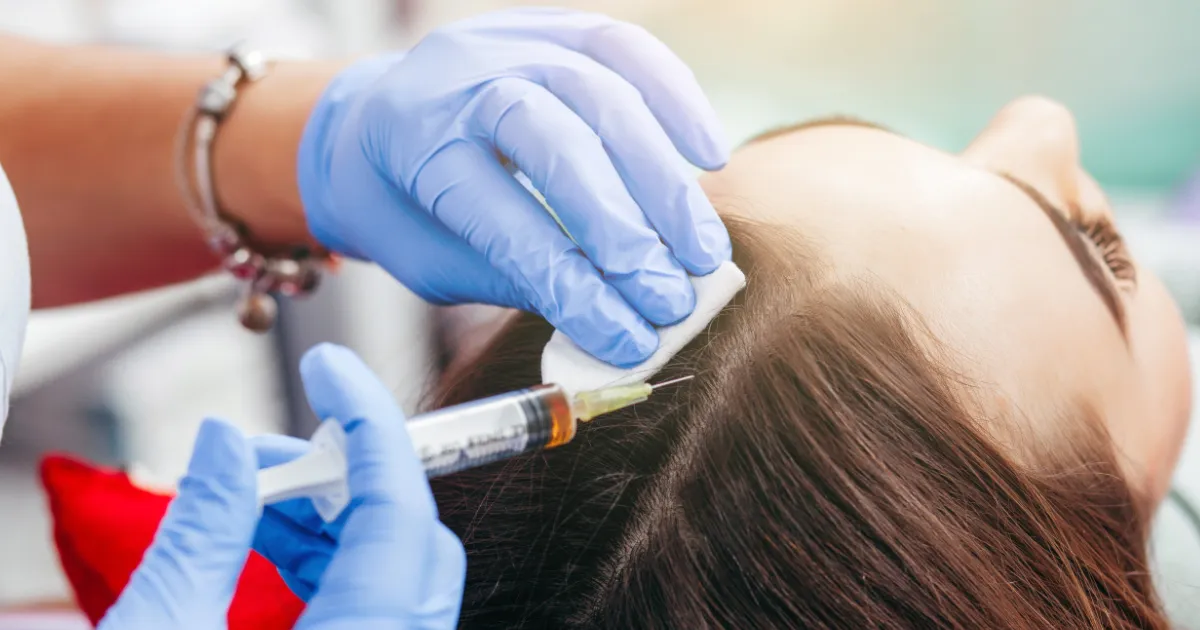What is PRP?
Platelet-rich plasma, also known as platelet-rich growth factors or platelet concentrate, is a concentrate of platelet-rich plasma protein derived from whole blood, centrifuged to remove red blood cells. This produces a small volume of plasma containing higher concentrations of platelets than those found in peripheral blood.
How does PRP work?
The mechanism of action is not entirely understood, and the science is not 100%. However, PRP injections are rich in proteins called growth factors, which may stimulate dormant hair follicles when injected into the scalp, encouraging hair regeneration.
What types of hair loss does PRP treat?
- Androgenic Alopecia
- Female pattern hair loss
- Alopecia Areata
- Cicatricial alopecia
- As an adjunct to hair transplantation
What is the process for PRP?
- All PRP preparation protocols follow a generic method, starting with collecting venous blood. Approximately 10-60 ML from the patient.
- The blood is then placed into tubes; whole blood is centrifuged and divided into three layers based on specific gravity. The bottom layer contains red blood cells (RBCs) with leukocytes, the middle layer is the PRP, and the top layer is platelet-poor plasma (PPP).
- The (PRP) is then separated from the red blood cells. This is repeated to ensure that no red blood cells remain.
- The (PRP) is then placed in sterile syringes in preparation for administration.
- Depending on provider preference, the injection site may be numbed with either topical medication or Lidocaine injections locally.
- The injection site is then cleansed and draped for administration.
- (PRP) is then injected into the subdermal portion of the scalp in 0.1 ml increments approximately 1 cm apart throughout the treatment area.
How long does PRP take to restore hair growth?
(PRP) treatments are provided approximately every four weeks until maximum growth is established. This may range from 6 to 10 treatments depending on the individual patient’s response to treatment. Then treatments are provided approximately every 4-6 months for maintenance of hair growth depending on the individual patients needs. Generally, new hair growth and follicular development will be noticeable approximately three weeks after treatment.
Does PRP hurt?
(PRP) injections can be painful, although the pain is felt only during the actual injection and subsides immediately after. The pain sensation has been described as stinging and can be tolerated without numbing, depending on the patient’s pain threshold. With the application of topical medication, the pain is minimal. With local anesthesia, no pain is felt during the administration process, but pain may be experienced during the initial numbing process.
How much does PRP cost?
PRP hair loss therapy involves three initial procedures in a 4 to 6-week period, followed by maintenance treatments every 4 to 6 months. The price of a PRP injection may start at $400, so you can expect your procedure to cost between $1500 and $3500 for initial sessions. These rates may vary according to:
- Location
- Experience and reputation of your practitioner
- Quality of the equipment used
- Other additional components to boost the effects of your procedure.
- Experience and reputation of your practitioner
- Quality of the equipment used
- Other additional components to boost the effects of your procedure.
Is PRP a permanent solution to hair loss?
Unfortunately, PRP can’t cure hair loss. It can only temporarily restore your follicles’ ability to regrow hair. So, it can’t be considered a permanent solution. The same is true of Rogaine and other hair regrowth products – they will require repeated use and are far more dangerous for your health than PRP.
Who can perform PRP?
- Registered nurses and nurse practitioners can administer PRP injections if they undergo special training for the procedure.
- Doctor’s assistants typically assist physicians in drawing blood from patients. However, in some areas, certified doctor’s assistants can directly administer the injections. The physician stays inside the room to observe and guide the assistant.
- Some dentists now use PRP injections to address chronic pain and discomfort in the jaw.
- Doctors are still the most common professionals who administer PRP injections.
Are there any contraindications to receiving PRP?
Patients with a medical condition that could worsen or spread with injections, such as an active infection, a metastatic disease, or certain skin diseases. Steroid therapy, dermatological diseases affecting the scalp (i.e., Porphyria), blood disorders and platelet abnormalities, and anticoagulation therapy (i.e., Warfarin).



